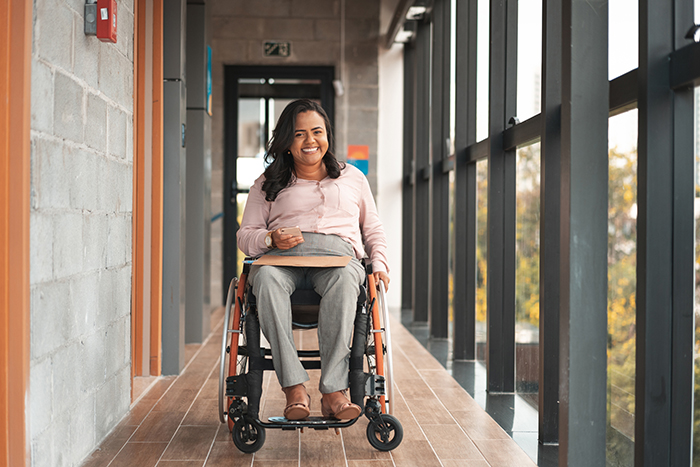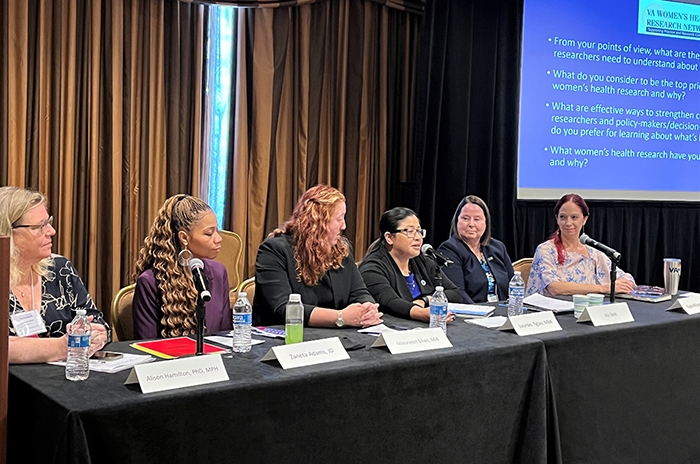Office of Research & Development |
 |


Researchers at the Hines VA Hospital recommend that providers ask Women Veterans what they need to accomplish in their daily lives, before prescribing assistive mobility technology. (Photo for illustrative purposes only, © iStock_PollyAnna Ventura)
September 12, 2023
By Erica Sprey
VA Research Communications
"I feel like I am Minnie Mouse, because I have to wear this large wheelchair glove."
Researchers at the Edward Hines Jr. VA Hospital in Illinois conducted a national survey to find where the mobility needs of Women Veterans’ had gone unmet, especially in design customization, shared decision making, and timely repairs. The responses they received painted a clear picture of frustration about the lack of customization, appropriate sizing, and respect.
“I feel like I am Minnie Mouse, because I have to wear this large wheelchair glove.”

Executive Order for Women’s Health built on VA research

VA Researcher Named One of U.S.’ Top Female Scientists

2023 VA Women's Health Research Conference

Self-harm is underrecognized in Gulf War Veterans
“I get issued male-size products for my feet. Very seldom do I get women’s sizes.”
“We have to deal with a lot of things that men don’t have to deal with. We’re challenged whether we should have served [in the military], even if we served for a long time and may have had some of the same injuries.”
The research team used data from VA’s Corporate Data Warehouse to identify Women Veterans who received their care from VA and were prescribed mobility assistive technology (devices like canes and walkers) within the past five years. They also identified women with spinal cord injuries who used assistive technology provided by VA (such as wheelchairs.) In total, more than 4,000 women were invited to participate in the survey.
Nearly 600 responses were returned and analyzed: a majority of the women were 50-69 years old, 27% reported multiple sclerosis, 60% reported a neuromuscular condition or arthritis, and 17% reported spinal cord injury. The most commonly used devices were canes, walkers, and wheelchairs.
“We weren’t sure what we were going to find, but we were interested in understanding the experiences of women’s health care needs,” said lead investigator Dr. Frances Weaver at the VA Center of Innovation for Complex Chronic Healthcare (CINCCH) in Hines, Illinois. “We specifically asked the women about activities like transportation, daily living, and employment, and how their devices supported their needs to do those kinds of things.”
A dominant theme emerged from the survey: a desire to customize mobility assistive technology to better fit women’s bodies and needs. Weaver’s team recommended the following to all medical providers in the VA:
“In our survey, we used several types of questions designed to assess women’s mobility, function, and experiences with their devices,” said Pooja Solanki, a CINCCH project manager on Weaver’s team. “We also included more open-ended questions to allow the women to expand on their experiences with their devices.”
Weaver and her team wanted to understand what it was like for Women Veterans with limited mobility to live their lives on a daily basis, and to use that information to inform policy makers about needed improvements. At the end of the survey, study participants were given a chance to request a telephone interview to speak with a researcher in further detail. Holding qualitative interviews added a richer picture of the women’s lives, according to Solanki.
“Speaking with study participants allowed us to go beyond the numbers,” she said. “For instance, we had one women who shared that she was unable to reach the countertop while seated in her wheelchair when she was preparing food.”
After analyzing the responses, the research team found that there were a number of areas where the study participants said their devices limited their function or made it difficult to access services like public transportation.
One quarter of the women said they felt uncomfortable sharing their concerns with their providers, and 50% said they did not have the option of trying out different devices before committing to one device. Overall, 20% to 30% of the women indicated that their mobility devices limited them in some respects.
The severity of the problem and need to improve has motivated Weaver and her team to present their findings to several groups of stakeholders, including the VA Office Of Geriatrics and Extended Care, Women’s Health, Rehabilitation and Prosthetics, and others. Solanki has presented the research findings at several external meetings like The Association of Public Health and VA Health Services Research.
“I think an important area of concern is daily needs—what an individual woman is going to be doing in her daily life. If providers take this information into account when they are prescribing some type of device, that would be very helpful and make a significant impact on these women’s lives,” said Weaver.
*To find out more about Women Veteran’s mobility needs see:
“Women Veteran’s Experiences with Mobility Assistive Technology” by Pooja Solanki.
VA Research Currents archives || Sign up for VA Research updates